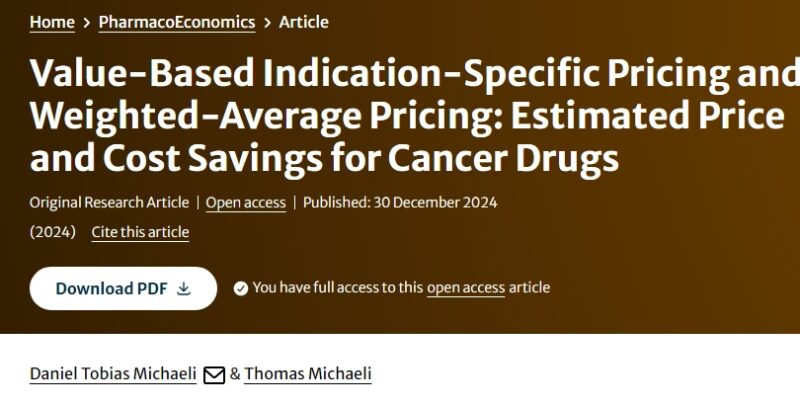Daniel Michaeli, a Medical Doctor at the National Center for Tumor Diseases (NCT) Heidelberg, shared a recent article on LinkedIn:
“How could patients and payers save $3 billion (or 11%) on cancer drugs?
Value-based indication-specific pricing or weighted-average pricing.
Excited to share our new article on Value-Based Indication-Specific Pricing and Weighted-Average Pricing: Estimated Price and Cost Savings for Cancer Drugs published in Chris Carswell’s Pharmaco-Economics after presenting the results at Dario Trapani’s ESMO 2024 session.
New drugs are increasingly approved for multiple indications with varying benefits and value for patients, e.g. immunotherapies or ADCs.
How should we price these multi-indication drugs? Two simple options (among others):
Indication-specific pricing: A distinct price is assigned to the differential value a drug offers in each indication (Peter B.).
Weighted-average pricing: A single drug price is calculated that reflects the value and/or volume of each indication.
We collected data from the FDA, Global Burden of Disease study, and clinicaltrials.gov on +120 cancer drugs with +300 indications to estimate US Centers for Medicare and Medicaid Services drug prices and spending under each policy in 2020.
Adopting value-based indication-specific pricing would increase drug prices by an average of 3.9%, with cost savings of $3 billion (10.6%).
Adopting value-based weighted-average pricing would reduce prices by an average of 4.6% and spending by $3 billion (10.6%).
However, under indication-based pricing, 43.7% higher prices for ultra-rare diseases would increase spending by 16.8% ($44 million).
Under weighted-average pricing, prices for and spending on ultra-rare diseases would be reduced by 22.6% and $55 million, respectively.
Value-based indication-specific and weighted-average pricing could help to align the value and price of new drug indications.
The adoption of these policies could be associated with considerable cost savings for payers and patients in the USA.”
Authors: Daniel Tobias Michaeli and Thomas Michaeli

Daniel Michaeli is a Medical Doctor at the National Center for Tumor Diseases (NCT) in Heidelberg and at Ruprecht-Karls University Heidelberg. His research focuses on drug development, clinical trials, and healthcare policy.
More posts featuring Daniel Michaeli.
